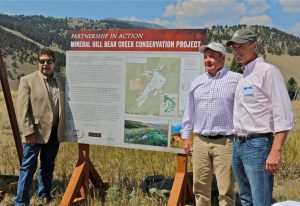July 11, 2025
One Big Beautiful Bill Raises Stakes for U.S. Mineral Production
One Big Beautiful Bill Raises Stakes for U.S. Mineral Production ...
Read More ›
Environmental stewardship and being a good neighbor are integral to the U.S. mining industry. Mining companies invest significant resources in the research and development of new technologies and processes that minimize environmental impact, ensuring mining operations maintain the highest possible standards for environmental protection. There are more than three dozen environmental laws – in addition to state and local laws – that govern all aspects of mining in the U.S. But the mining industry is committed to going above and beyond what is required by law.

Below are just a few of the many examples of mining’s contributions to environmental stewardship.
Newmont Goldcorp has made major strides in creating sustainability initiatives using protocols from the International Union for Conservation of Nature (IUCN). In 2018, Newmont Goldcorp started a three-year partnership with the IUCN to help achieve their goal of no net biodiversity loss, with net gains where possible. These types of relationships are essential to achieving the U.S. mining industry goals of operating safe and stable mining projects.

Another example of a mining operation positively impacting the environment is Kinross Gold, with its largescale environmental conservation initiative to protect the wildlife of Yellowstone National Park. Partnering with Trout Unlimited and the Rocky Mountain Elk Foundation, Kinross has worked to protect important fish and wildlife habitat adjacent to the park. As part of its remediation and reclamation plans, the mining company donated water rights of approximately three billion gallons of water, and 549 acres of land. Furthermore, the company has worked with the U.S. Bureau of Land Management to protect the natural habitats of mule deer, sage grouse, wild horses and golden eagles living near its Bald Mountain mine.
Today’s mining industry frequently supports state and federal regulatory agencies in their efforts to address risks associated with legacy abandoned mine sites. In fact, many National Mining Association member organizations were influential in establishing what is now standard practice. Take for example Newmont Goldcorp’s work in Colorado. The mining company built a relationship with the state of Colorado during the 1990’s to establish the Remedial Action Plan, which included groundbreaking actions to revegetate tailings piles and foster plant growth, while also administering source control techniques to prevent water acidification. Newmont remains committed to its remediation efforts, having reduced zinc levels in nearby watersheds by 25 percent.
To learn more about the reclamation process and our member companies’ contributions to creating wildlife habitats and community spaces, see the National Mining Association’s June blog here.
Through replenishing the soil and encouraging the return of wildlife, the mining industry is ensuring its footprint is smaller than ever before.
Want to get an inside look at the modern-day mine? See our video.